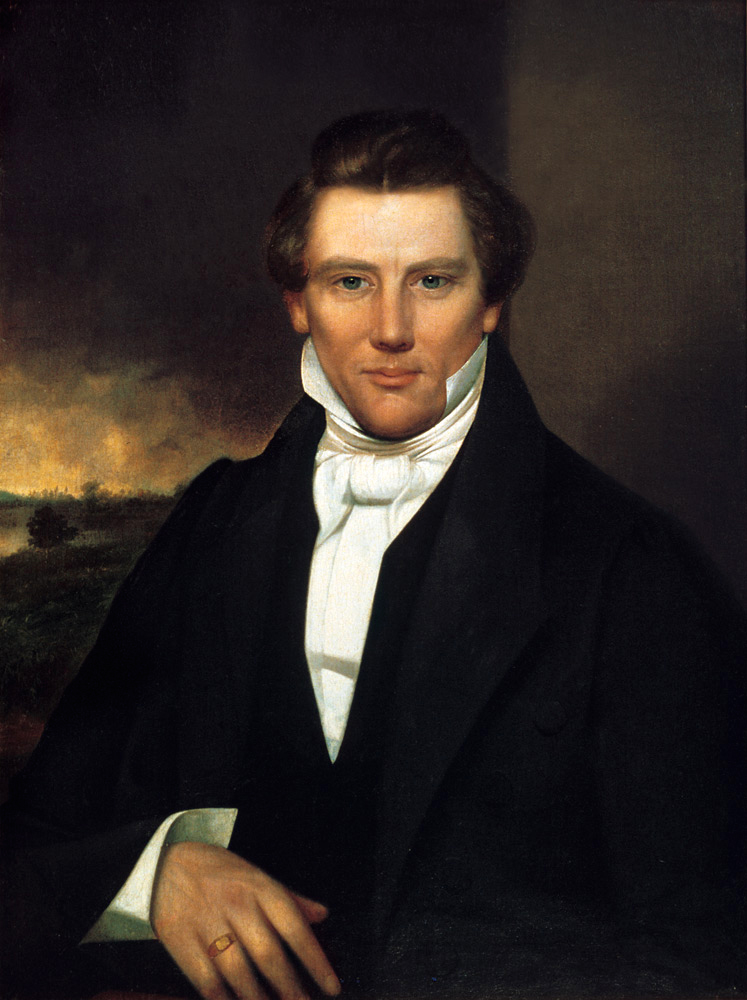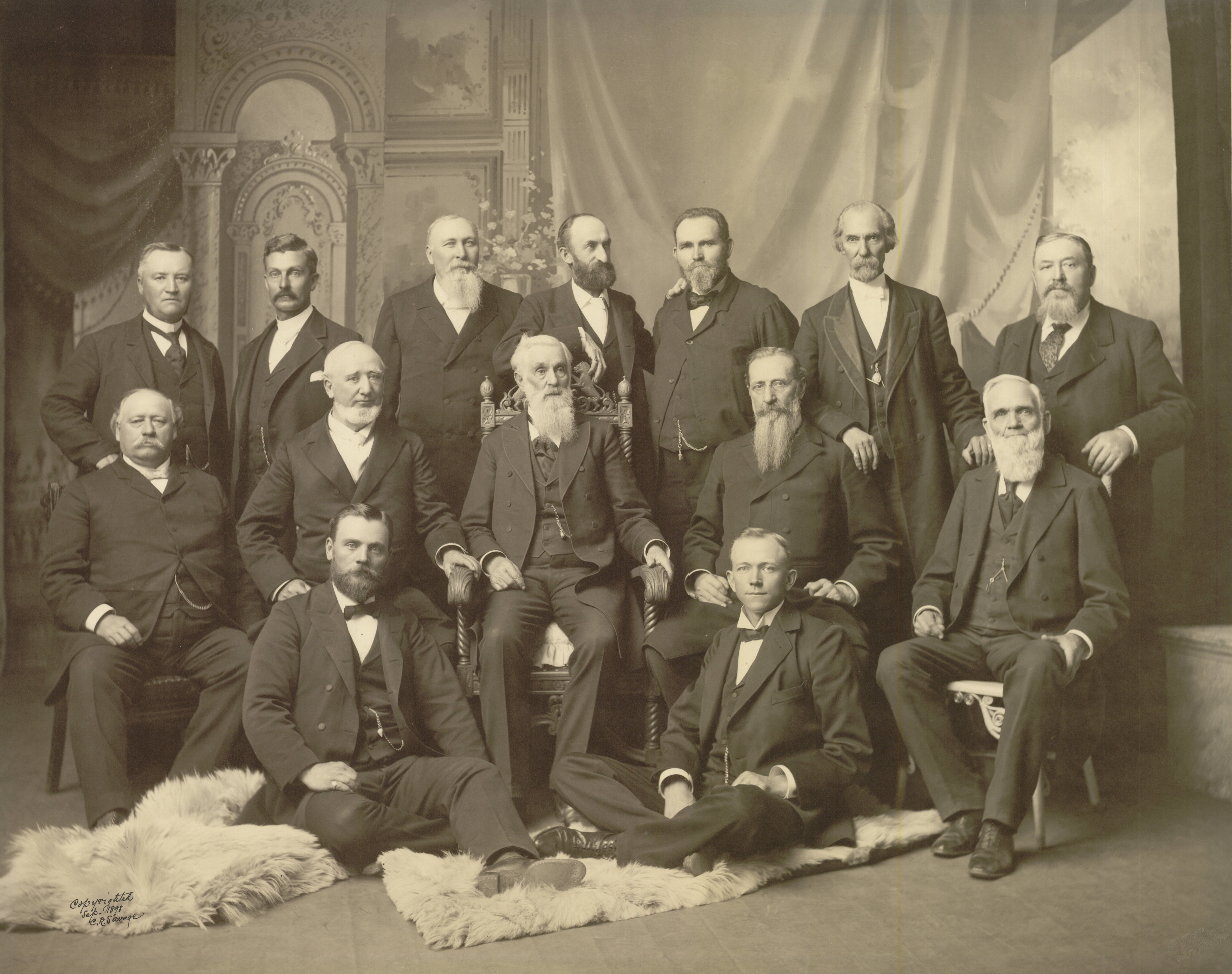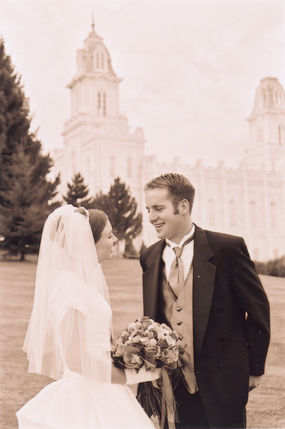|
Black People And Mormon Priesthood
From 1849 to 1978, The Church of Jesus Christ of Latter-day Saints (LDS Church) prohibited men of black African descent from being ordained to the priesthood. In 1978, the church's First Presidency declared in a statement known as " Official Declaration 2" that the restriction had been lifted. Between 1830 and 1849, a few black men had been ordained to the priesthood under Joseph Smith. As part of this restriction, both black men and women of African descent at various times were prohibited from taking part in ceremonies in LDS temples, serving in certain leadership church callings, attending priesthood meetings, and speaking at firesides. Spouses of black people of African descent were also prohibited from entering the temple. Over time, the restriction was relaxed so that dark-skinned people of non-African descent could attend priesthood meetings and people with a "questionable lineage" were given the priesthood, such as Fijians, Indigenous Australians, Egyptians, as well as ... [...More Info...] [...Related Items...] OR: [Wikipedia] [Google] [Baidu] |
The Church Of Jesus Christ Of Latter-day Saints
The Church of Jesus Christ of Latter-day Saints, informally known as the LDS Church or Mormon Church, is a Nontrinitarianism, nontrinitarian Christianity, Christian church that considers itself to be the Restorationism, restoration of the One true church#Latter Day Saint movement, original church founded by Jesus in Christianity, Jesus Christ. The church is headquartered in the United States in Salt Lake City, Salt Lake City, Utah, and has established congregations and built Temple (LDS Church), temples worldwide. According to the church, it has over 16.8 million the Church of Jesus Christ of Latter-day Saints membership statistics, members and 54,539 Missionary (LDS Church), full-time volunteer missionaries. The church is the Christianity in the United States, fourth-largest Christian denomination in the United States, with over 6.7 million US members . It is the List of denominations in the Latter Day Saint movement, largest denomination in the Latter Day Saint m ... [...More Info...] [...Related Items...] OR: [Wikipedia] [Google] [Baidu] |
Apostle (Latter Day Saints)
In the Latter Day Saint movement, an apostle is a "special witness of the name of Jesus Christ who is sent to teach the principles of salvation to others." In many Latter Day Saint churches, an apostle is a priesthood office of high authority within the church hierarchy. In many churches, apostles may be members of the Quorum of the Twelve and First Presidency of the church. In most Latter Day Saint churches, modern-day apostles are considered to have the same status and authority as the Biblical apostles. In the Latter Day Saint tradition, apostles and prophets are believed to be the foundation of the church, Jesus Christ himself being the chief cornerstone. The "Articles of Faith", written by Joseph Smith, mentions apostles: "We believe in the same organization that existed in the Primitive Church, namely, apostles, prophets, pastors, teachers, evangelists, and so forth." History Joseph Smith and Oliver Cowdery were both designated apostles by 1830. The founding articles a ... [...More Info...] [...Related Items...] OR: [Wikipedia] [Google] [Baidu] |
Rite Of Passage
A rite of passage is a ceremony or ritual of the passage which occurs when an individual leaves one group to enter another. It involves a significant change of status in society. In cultural anthropology the term is the Anglicisation of ''rite de passage'', a French term innovated by the ethnographer Arnold van Gennep in his work ''Les rites de passage'', ''The Rites of Passage''. The term is now fully adopted into anthropology as well as into the literature and popular cultures of many modern languages. Original conception In English, Van Gennep's first sentence of his first chapter begins: "Each larger society contains within it several distinctly separate groupings. ... In addition, all these groups break down into still smaller societies in subgroups." The population of a society belongs to multiple groups, some more important to the individual than others. Van Gennep uses the metaphor, "as a kind of house divided into rooms and corridors." A passage occurs when an indi ... [...More Info...] [...Related Items...] OR: [Wikipedia] [Google] [Baidu] |
Aaronic Priesthood (LDS Church)
The Aaronic priesthood (; also called the priesthood of Aaron or the Levitical priesthood) is the lesser of the two (or sometimes three) orders of priesthood recognized in the Latter Day Saint movement. The others are the Melchizedek priesthood and the rarely recognized Patriarchal priesthood. Unlike the Melchizedek priesthood, which is modeled after the authority of Jesus and the Twelve Apostles, or the Patriarchal priesthood, which is modeled after the authority of Abraham, the Aaronic priesthood is modeled after the priesthood of Aaron the Levite, the first high priest of the Hebrews, and his descendants. The Aaronic priesthood is thought to be a lesser or preparatory priesthood and an "appendage" of the more powerful Melchizedek priesthood. In the Church of Jesus Christ of Latter-day Saints (LDS Church) today, the holders of the Aaronic priesthood are primarily young men ages 11 to 18 and recent adult male converts to the church. The general leadership of the Aaronic prie ... [...More Info...] [...Related Items...] OR: [Wikipedia] [Google] [Baidu] |
Laity
In religious organizations, the laity () consists of all members who are not part of the clergy, usually including any non-ordained members of religious orders, e.g. a nun or a lay brother. In both religious and wider secular usage, a layperson (also layman or laywoman) is a person who is not qualified in a given profession or does not have specific knowledge of a certain subject. The phrase "layman's terms" is used to refer to plain language that is understandable to the everyday person, as opposed to specialised terminology understood only by a professional. Some Christian churches utilise lay preachers, who preach but are not clergy. The Church of Jesus Christ of Latter-day Saints uses the term ''lay priesthood'' to emphasise that its local congregational leaders are unpaid. Terms such as ''lay priest'', ''lay clergy'' and ''lay nun'' were once used in certain Buddhist cultures to indicate ordained persons who continued to live in the wider community instead of retiring t ... [...More Info...] [...Related Items...] OR: [Wikipedia] [Google] [Baidu] |
Polynesian People
Polynesians form an ethnolinguistic group of closely related people who are native to Polynesia (islands in the Polynesian Triangle), an expansive region of Oceania in the Pacific Ocean. They trace their early prehistoric origins to Island Southeast Asia and form part of the larger Austronesian ethnolinguistic group with an Urheimat in Taiwan. They speak the Polynesian languages, a branch of the Oceanic subfamily of the Austronesian language family. there were an estimated 2 million ethnic Polynesians (full and part) worldwide, the vast majority of whom either inhabit independent Polynesian nation-states (Samoa, Niue, Cook Islands, Tonga, and Tuvalu) or form minorities in countries such as Australia, Chile (Easter Island), New Zealand, France (French Polynesia and Wallis and Futuna), and the United States (Hawaii and American Samoa), in addition to the British Overseas Territory of the Pitcairn Islands. New Zealand had the highest population of Polynesians, estimated at 110, ... [...More Info...] [...Related Items...] OR: [Wikipedia] [Google] [Baidu] |
Melanesians
Melanesians are the predominant and indigenous inhabitants of Melanesia, in a wide area from Indonesia's New Guinea to as far East as the islands of Vanuatu and Fiji. Most speak either one of the many languages of the Austronesian language family, especially ones in the Oceanic branch, or from one of the many unrelated families of Papuan languages. Other languages are the several creoles of the region, such as Tok Pisin, Hiri Motu, Solomon Islands Pijin, Bislama, and Papuan Malay. Origin and genetics The original inhabitants of the group of islands now named Melanesia were likely the ancestors of the present-day Papuan people. They appear to have occupied these islands as far east as the main islands in the Solomon Islands, including Makira and possibly the smaller islands farther to the east. Particularly along the north coast of New Guinea and in the islands north and east of New Guinea, the Austronesian people, who had migrated into the area more than 3,000 years ago, c ... [...More Info...] [...Related Items...] OR: [Wikipedia] [Google] [Baidu] |
Hispanic People
The term ''Hispanic'' ( es, hispano) refers to people, cultures, or countries related to Spain, the Spanish language, or Hispanidad. The term commonly applies to countries with a cultural and historical link to Spain and to viceroyalties formerly part of the Spanish Empire following the Spanish colonization of the Americas, parts of the Asia-Pacific region and Africa. Outside of Spain, the Spanish language is a predominant or official language in the countries of Hispanic America and Equatorial Guinea. Further, the cultures of these countries were influenced by Spain to different degrees, combined with the local pre-Hispanic culture or other foreign influences. Former Spanish colonies elsewhere, namely the Spanish East Indies (the Philippines, Marianas, etc.) and Spanish Sahara (Western Sahara), were also influenced by Spanish culture, however Spanish is not a predominant language in these regions. Hispanic culture is a set of customs, traditions, beliefs, and art forms (music, ... [...More Info...] [...Related Items...] OR: [Wikipedia] [Google] [Baidu] |
Indigenous Peoples Of The Americas
The Indigenous peoples of the Americas are the inhabitants of the Americas before the arrival of the European settlers in the 15th century, and the ethnic groups who now identify themselves with those peoples. Many Indigenous peoples of the Americas were traditionally hunter-gatherers and many, especially in the Amazon basin, still are, but many groups practiced aquaculture and agriculture. While some societies depended heavily on agriculture, others practiced a mix of farming, hunting, and gathering. In some regions, the Indigenous peoples created monumental architecture, large-scale organized cities, city-states, chiefdoms, states, kingdoms, republics, confederacies, and empires. Some had varying degrees of knowledge of engineering, architecture, mathematics, astronomy, writing, physics, medicine, planting and irrigation, geology, mining, metallurgy, sculpture, and gold smithing. Many parts of the Americas are still populated by Indigenous peoples; some countries have ... [...More Info...] [...Related Items...] OR: [Wikipedia] [Google] [Baidu] |
Jane Elizabeth Manning James
Jane Elizabeth Manning James (1822 – April 16, 1908), fondly known as "Aunt Jane", was one of the first recorded African-American women to enter Utah. She was a member of the Church of Jesus Christ of Latter Day Saints and lived with Joseph Smith and his family for a time in Nauvoo, Illinois. She traveled with her husband to Utah, spending the winter of 1846–1847 at Winter Quarters. She petitioned the First Presidency to be endowed and sealed; as a result of her requests she was adopted as a servant into the Joseph Smith family through a specially created temple ceremony. Not satisfied to be an eternal servant in the Smith family, she continued to petition to receive her own temple endowment but was denied these rites during her lifetime. She was posthumously endowed by proxy in the Salt Lake Temple in 1979. Early life in Connecticut Jane Elizabeth Manning James was born in Wilton, Connecticut, to Isaac Manning and Eliza Phyllis Mead. Although late in Jane's life her brot ... [...More Info...] [...Related Items...] OR: [Wikipedia] [Google] [Baidu] |
Baptism For The Dead
Baptism for the dead, vicarious baptism or proxy baptism today commonly refers to the religious practice of baptizing a person on behalf of one who is dead—a living person receiving the rite on behalf of a deceased person. Baptism for the dead is best known as a doctrine of the Latter Day Saint movement, which has practiced it since 1840. It is currently practiced by the Church of Jesus Christ of Latter-day Saints (LDS Church), where it is performed only in dedicated temples, as well as in several other current factions of the movement. Those who practice this rite view baptism as an essential requirement to enter the Kingdom of God, and therefore practice baptism for the dead to offer it by proxy to those who died without the opportunity to receive it. The LDS Church teaches that those who have died may choose to accept or reject the baptisms done on their behalf. Baptism for the dead is mentioned in () as proof of a physical resurrection, though the exact meaning of the phra ... [...More Info...] [...Related Items...] OR: [Wikipedia] [Google] [Baidu] |
Celestial Marriage
Celestial marriage (also called the New and Everlasting Covenant of Marriage, Eternal Marriage, Temple Marriage) is a doctrine that marriage can last forever in heaven. This is a unique teaching of the Church of Jesus Christ of Latter-day Saints (LDS Church) or Mormonism, and branches of Mormon fundamentalism. In the LDS Church Within the LDS Church, family relationships can be sealed, thereby continuing beyond death, via the sealing ordinance. The ordinance is associated with a covenant that takes place inside temples by those authorized to hold the sealing power. The only people allowed to enter the temple, be married there, or attend these sealings are those who hold an official temple recommend. Obtaining a temple recommend requires one to abide by LDS Church doctrine and be interviewed and considered worthy by their bishop and stake president. A prerequisite to contracting an eternal marriage, in addition to obtaining a temple recommend, involves undergoing the temple endo ... [...More Info...] [...Related Items...] OR: [Wikipedia] [Google] [Baidu] |



.jpg)


_2007.jpg)

